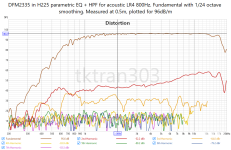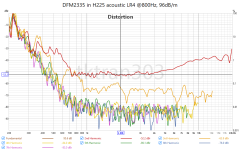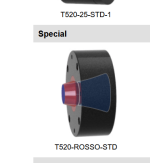I've added two new adapters:
The 2" throat, simulated polars 0 - 90/10°:

(It's at least for completeness. Perhaps someone finds it usable for their needs.)
- This is the 1" for comparison:

T520-25-STD-3, standard 1" with 22° input angle, e.g. for the DFM-2535,
T520-50-STD-1, a basic throat for 2" drivers.
The 2" throat, simulated polars 0 - 90/10°:
(It's at least for completeness. Perhaps someone finds it usable for their needs.)
- This is the 1" for comparison:
Last edited:
The 1" Peerless measured with the STD-3 adapter, on axis. That's all I can handle today 🙂

- Some off-axis angles, and now I really need to go...


- Some off-axis angles, and now I really need to go...
Last edited:
I am tempted to join, but to pull the trigger I would need the comfort of an existing design that incorporates those and an ATH4 based horn.
@ElEsido now you have it -> post #15,442 😉
I've looked at the FR plots for this very interesting driver.
Would it reach down to 800 or 900Hz with some meaningful output?
800 Hz is possible with a standard LR4 crossover, as has been measured by @tktran303. This appears to be a reasonable limit for this driver and is still on par with the Genelec S360's performance at 96 dB, which is crossed at 1.5 kHz. HD3 begins to rise but is still perfectly acceptable. Absolute values for the DFM 2525R00-008 LR4 at 800 Hz at 96 dB at 1 m:


You might want to ask @tktran303 in his thread if he can provide distortion measurement for a 1st order XO at 800 Hz.
Now we really reached optimum performance! What is the driver exit diameter with the custom ring insert applied (in mm)?
34 pairs left ->
Group Buy: Peerless by Tympahny DFM-2535R00-08 (unobtanium extraordinary HiFi compression driver bulk order)
Lavoce DF10.171K vs DFM 2525R00-008.
Lavoce drops off at 17k hz, but gains extension to ~500hz?
DFM goes up to about 18k hz, but extends to about 800 usable with a 1.1k hz LR24.
Am I missing other differences?
Why the DFM over the Lavoce?
I’m coming into this discussion very late and I might have missed this discussion earlier, but the group buy is interesting.
I’d probably be looking for a two way design with these and a high output 12” or 15” woofer down to 80hz. Not sure which would be better.
Lavoce drops off at 17k hz, but gains extension to ~500hz?
DFM goes up to about 18k hz, but extends to about 800 usable with a 1.1k hz LR24.
Am I missing other differences?
Why the DFM over the Lavoce?
I’m coming into this discussion very late and I might have missed this discussion earlier, but the group buy is interesting.
I’d probably be looking for a two way design with these and a high output 12” or 15” woofer down to 80hz. Not sure which would be better.
800 Hz is possible with a standard LR4 crossover, as has been measured by @tktran303. This appears to be a reasonable limit for this driver and is still on par with the Genelec S360's performance at 96 dB, which is crossed at 1.5 kHz. HD3 begins to rise but is still perfectly acceptable. Absolute values for the DFM 2525R00-008 LR4 at 800 Hz at 96 dB at 1 m:
Off topic now..
I have the MEH / Synergy conundrum of the MF drivers not reaching higher than 950 or so.
But must have no more than a 1st order phase shift on the HF comp driver XO.
Bizarrely a 3uF cap on the 15 Ohm S2s gives a somewhat steeper than 1st order when measured, and only a 90 degree phase shift - neat trick.
I do look for a little more HF extension at times. The BMS4550 gives this but lack a smoother sound.
The Eminence N314T perhaps but $$$ on a punt - no way to hear it first!
I haven't tried. But there's the drawing of the driver available (hopefully the correct one), so you can try to come up with something.What is the driver exit diameter with the custom ring insert applied (in mm)?
But apparently it has been already optimized, so the question is if there's any room for improvement.
I consider both quite similar in the end, the Lavoce having a bit more headroom due to the larger diaphragm.Lavoce DF10.171K vs DFM 2525R00-008.
Last edited:
There is the notion that TI diaphragms are more resolving in the high frequencies than those made from polyimide, and that a polyimide surround allows for a smooth or 'natural' sound, that is usually associated with compression drivers using polyimide / polymer diaphragms. This construction, combining TI diaphragm and polyimide surrounds, is what the Peerless/Tymphany driver offers over the LaVoce.
My bad, I thought you had designed something similar to the ROSSO adapter, where the exit diameter at the phase plug has to be considered:

Group Buy: Peerless by Tympahny DFM-2535R00-08 (unobtanium extraordinary HiFi compression driver bulk order)
I haven't tried.
My bad, I thought you had designed something similar to the ROSSO adapter, where the exit diameter at the phase plug has to be considered:

Group Buy: Peerless by Tympahny DFM-2535R00-08 (unobtanium extraordinary HiFi compression driver bulk order)
Isn't the acoustic outcome all that matters? Looking just at the measured data (without knowing the materials used), how do you recognize the one "more resolving in the high frequencies"?
The top octave of the DFM-2535 isn't any extraordinarily good. Fortunately, this is not what makes it sound good or bad - it just doesn't matter much, IMO. It's the overall smoothness of the response of this driver (being free of resonances) that's striking, at least not so often to be seen. When EQed to flat, I doubt that any significant audible differences remain, though, e.g. when compared with the DF10.171K, which seems to be only marginally worse in terms of the overall smoothness.
The top octave of the DFM-2535 isn't any extraordinarily good. Fortunately, this is not what makes it sound good or bad - it just doesn't matter much, IMO. It's the overall smoothness of the response of this driver (being free of resonances) that's striking, at least not so often to be seen. When EQed to flat, I doubt that any significant audible differences remain, though, e.g. when compared with the DF10.171K, which seems to be only marginally worse in terms of the overall smoothness.
Last edited:
Here are 96dB SPL distortion measurements for a small wideband driver, Tectonic TEBM35C10, with the same SD of approx. 11cm2 as the Peerless 2535.
https://www.erinsaudiocorner.com/driveunits/tectonic-elements-tebm35c10-4-miniature-bmr-driver/
Distortion is approx. -40dB or better above say 700Hz. (Blue line.) For half-space SPL of 96dB at 700Hz that's approx. 0.44mm excursion. That would seem to be the upper limit for excursion where driver still performs well.
With an LR4 crossover that is -6dB at 700Hz that would mean 102dB SPL in the mid-band. This is without phase plug and waveguide. (But wide baffle and ignoring power handling.)
The Xmax spec for the Peerless 2535 is 0.1mm. On the graph above at 700Hz the 2nd and 3rd harmonics are about the same, approx. -45dB. This is more for 96dB SPL in the mid-band. (Although I'm ignoring that the 3rd harmonic drops much lower from 1kHz, but in this case there is also a WG.)
The Xmax spec for the larger Peerless 2544 is 0.3mm and the Sd is approx. 1.5x larger. (Coincidentally that's similar displacement as the case of 0.44mm excursion with Sd of 11cm2 above.)
I just wonder what is the primary factor for the excursion limit. Is the phase plug that close? The smaller gap height? The motor of the smaller Peerless 2535 is a lot stronger.
https://www.erinsaudiocorner.com/driveunits/tectonic-elements-tebm35c10-4-miniature-bmr-driver/
Distortion is approx. -40dB or better above say 700Hz. (Blue line.) For half-space SPL of 96dB at 700Hz that's approx. 0.44mm excursion. That would seem to be the upper limit for excursion where driver still performs well.
With an LR4 crossover that is -6dB at 700Hz that would mean 102dB SPL in the mid-band. This is without phase plug and waveguide. (But wide baffle and ignoring power handling.)
The Xmax spec for the Peerless 2535 is 0.1mm. On the graph above at 700Hz the 2nd and 3rd harmonics are about the same, approx. -45dB. This is more for 96dB SPL in the mid-band. (Although I'm ignoring that the 3rd harmonic drops much lower from 1kHz, but in this case there is also a WG.)
The Xmax spec for the larger Peerless 2544 is 0.3mm and the Sd is approx. 1.5x larger. (Coincidentally that's similar displacement as the case of 0.44mm excursion with Sd of 11cm2 above.)
I just wonder what is the primary factor for the excursion limit. Is the phase plug that close? The smaller gap height? The motor of the smaller Peerless 2535 is a lot stronger.
The motor of the smaller Peerless 2535 is a lot stronger.
And Bl^2/Re for that Tectonic driver is about 40% higher than for the larger Peerless 2544, but it has 3 times the Mms.
Such a flat diaphragm could potentially be convenient for a phase plug experiment, too bad the surround isn't flat.
One would have to make his own driver with an exciter such as https://www.soundimports.eu/en/dayton-audio-daex25fhe-4.html plus honeycomb diaphragm, flat surround, basket. 😀
I think the 0.1mm Xmax for the 2535 was somehow derived from the gap/VC geometry. The distance between the diaphragm and the phase plug seems considerably larger than that, looking at the drawing.
Here is a post that supports your assumption, @mabat, quoting from a TU Berlin thesis on the question of driver material for tweeters: -> link. Even the differences in temporal behavior weren't significant enough to stand out.
Personally, I strongly believe in the power of linear distortion and its control via EQ. This believe is solely based on my experience that a DSP amplifier offered, continuously comparing minuscule changes in the settings of three DSP banks. So maybe driver material it is not important and even the statement of the two sales persons of B&C, Bennett Prescott, and Matteo Bianchini of 18Sound, was wring, who kept with the believe that diaphragm material has a sound signature,
However, I sometimes have the impression that my Celestion CDX1-1747, with its polyimide diaphragm, while sounding smooth, should provide more detail. And this might just be a typical case of upgraditis.
In any case, please all commit to the group buy, I want to hear it with my ears ;D
Group Buy: Peerless by Tympahny DFM-2535R00-08 (unobtanium extraordinary HiFi compression driver bulk order)
Personally, I strongly believe in the power of linear distortion and its control via EQ. This believe is solely based on my experience that a DSP amplifier offered, continuously comparing minuscule changes in the settings of three DSP banks. So maybe driver material it is not important and even the statement of the two sales persons of B&C, Bennett Prescott, and Matteo Bianchini of 18Sound, was wring, who kept with the believe that diaphragm material has a sound signature,
However, I sometimes have the impression that my Celestion CDX1-1747, with its polyimide diaphragm, while sounding smooth, should provide more detail. And this might just be a typical case of upgraditis.
In any case, please all commit to the group buy, I want to hear it with my ears ;D
Group Buy: Peerless by Tympahny DFM-2535R00-08 (unobtanium extraordinary HiFi compression driver bulk order)
That's the usual way of calculation.I think the 0.1mm Xmax for the 2535 was somehow derived from the gap/VC geometry. The distance between the diaphragm and the phase plug seems considerably larger than that, looking at the drawing.
Polyamide has been getting better and better. You might know or might not know that the metal diaphragms are getting most of their output above 10k via harmonics. More to the point, vibrations that are present because of the material choice and how it reacts in the pressure field driven from the circumference more or less. Polyamide has it's own internal resonances but they are different than Titanium and Auminium. Berylium being one of the few that has little breakup or harmonics up to 20k and a little beyond. There are also Carbon fibre diaphragms via Composite Sound that are different again. I only know of Eminence using them, but I am not up to date in everything Pr-Sound.So maybe driver material it is not important and even the statement of the two sales persons of B&C, Bennett Prescott, and Matteo Bianchini of 18Sound, was wring, who kept with the believe that diaphragm material has a sound signature,
However, I sometimes have the impression that my Celestion CDX1-1747, with its polyimide diaphragm, while sounding smooth, should provide more detail. And this might just be a typical case of upgraditis.
Looking at how coherent the responses are above 10 kHz, I doubt this is the case for these smaller drivers.You might know or might not know that the metal diaphragms are getting most of their output above 10k via harmonics.
- BTW, the HF response of the Peerless 2544 falls quite rapidly above 10 kHz. It's still smooth but the diaphragm seems just too heavy. Perhaps this is due to the damping layer.
Which is why I asked for CSD graph. Some do have serious breakup some have minimal break up. I should have stated that in my post! Thanks for clarifying the measurement that you posted.Looking at how coherent the responses are above 10 kHz, I doubt this is the case for these smaller drivers.
I still don't understand what you are looking for, on top of these graphs:


It's obvious from these curves where are the drivers still well-behaved - all the way up to the points where the responses start to fall. Since the polars are so consistent, both can be EQed to virtually any shape desired, and it will be still well-behaved. I'm not so interested what exactly happens around 20 kHz here, as it's outside the bandwidth.
It's obvious from these curves where are the drivers still well-behaved - all the way up to the points where the responses start to fall. Since the polars are so consistent, both can be EQed to virtually any shape desired, and it will be still well-behaved. I'm not so interested what exactly happens around 20 kHz here, as it's outside the bandwidth.
Last edited:
- Home
- Loudspeakers
- Multi-Way
- Acoustic Horn Design – The Easy Way (Ath4)